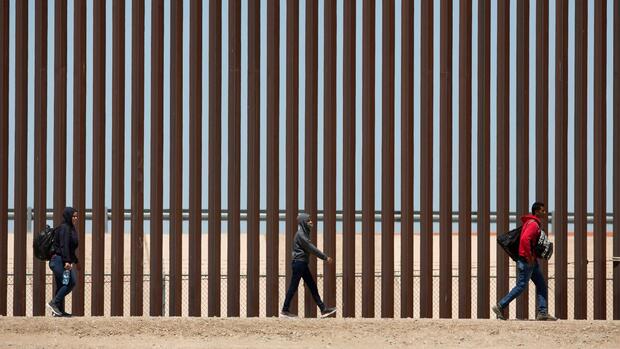Mexico City In the USA, the deportation regulation “Title 42” ends – and Irineo Mujica expects dramatic scenes. Everywhere in Mexico, migrants are waiting to cross the border, says the director of the migrant organization Pueblo Sin Fronteras (PSF). In the past few weeks, Mujica has accompanied a group of originally around 3,000 people on their way through Mexico.
In the spring of 2020, the government of then US President Donald Trump allegedly issued the regulation known as Title 42 to protect against the spread of the corona virus. The border guards were thus given permission to reject arriving immigrants and those seeking protection at the border. Officials used this opportunity more than 2.5 million times.
The end of the travel ban on May 11 is now causing unrest from southern to northern Mexico. In the Mexican city of Tapachula on the border with Guatemala, migrants are fighting for the coveted 45-day permits that Mexico issues for safe transit to the US border. Both in Mexico City and on the northern border, people are making their way to the USA.
Many men and women are expected to apply for asylum in the US once the rule expires – and not just people from South America. Nicaraguans, Cubans, Venezuelans and Haitians are also hoping for one of the 30,000 monthly residence permits that Washington has offered for these four countries.
But the majority of immigrants from the South will continue to wander unnoticed through the desert or swim across the border river, the Rio Grande, as “Mojado”, undocumented migrants who find holes in the fence. This “illegal migration” has not stopped Title 42 either. Around 7,000 people are apprehended by border guards every day along the 3,200-kilometer border between Tijuana on the Pacific and Matamoros on the Gulf of Mexico.
A lack of prospects drives people to flee – including the middle class
People are fleeing their countries of origin from poverty, violence, autocratic regimes, natural disasters and organized crime. Dieter Müller, office manager of the Rosa Luxemburg Foundation in Mexico City, also observes a different development. It has long been “not just the poorest of the poor who are on the move”.
The well-educated middle class is also trying to escape the lack of prospects in countries like Cuba, Haiti and Venezuela. Instead of young men traveling alone, more and more women, minors and entire families are now traveling, says Müller.
Some immigrants didn’t want to wait for Thursday. Among them is Jhoan Barrios. According to his own statements, the Venezuelan arrived in Ciudad Juárez a few days ago after a four-month hike from his Venezuelan hometown of Barinas through the Darién jungle, Central America and Mexico.
Members of the Texas National Guard board a plane that will take them to the Texas-Mexico border.
(Photo: dpa)
He saw dead people in the Darién jungle, was attacked and robbed several times, fell ill and got sore feet. The 33-year-old former manager of a clothing factory and his wife never thought of turning back: “We sold everything, a dignified life is no longer possible in Venezuela, so people go to the dogs,” says the slim man with short hair .
As soon as he arrived in Juárez, he tried to apply for asylum via the US authorities’ app CBP One. “But the app always breaks down.” So he decided to take the route away from the official border crossings. However, the mafia and Mexican soldiers shot at him.
Nevertheless, he made it to the USA. He turned himself in to the authorities along with 2,000 other migrants from Venezuela, Colombia and Turkey. But he hasn’t finally reached his goal yet. He either ends up in a reception center – or in prison. He hopes to get preferential treatment as a Venezuelan.
It is questionable whether the hopes of the migrants will be fulfilled and whether they will now be able to get to the USA much more easily. Migration researcher María Inés Barrios is also skeptical. “Migrants believe the end of Title 42 will open the doors for them to enter the US and seek asylum.”
Hundreds of people are waiting in the no man’s land between the United States and Mexico
In fact, the opposite is the case. After May 11, anyone attempting to enter the country irregularly will be deported under regular immigration law. Accordingly, there is even a risk of a five-year entry ban. In addition, there is still a lack of a comprehensive and uniform migration policy in the region, in which there is hardly any political interest.
>> Read here: USA, Mexico and Canada intensify cooperation – focus on rare earths, e-cars and semiconductors
Foundation representative Müller refers to the new migration centers that Washington wants to set up in Guatemala and Colombia. In these “regional processing centers” people who want to go to the USA should be able to apply for entry. According to the US government, “irregular migration” should be limited and “safe, orderly, humane and legal paths” should be created.
The USA outsourced migration in a similar way to Italy in Libya and Germany in Turkey, criticizes Müller. However, this does not limit migration movements.
PSF activist Irineo Mujica is also clear: “These are containment measures that don’t work. The migration continues and with it the torture for the people.” It only helps to stabilize the countries from which the people are fleeing politically, economically and socially. “Only then will the migration pressure ease.”
More: What makes Mexico so attractive for German emigrants
